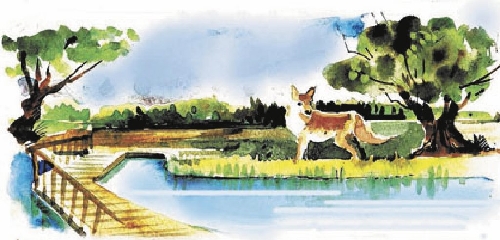Ash Meadows Wildlife Refuge preserves unique area
Ash Meadows National Wildlife Refuge, the largest oasis in the Mojave Desert, preserves more than 50 springs, which feed streams, wetlands and reservoirs. The area is home to many unique types of plants and wildlife and attracts at least 275 kinds of birds, 27 species of mammals, a wide assortment of snakes and lizards as well as fish, amphibians and insects.
Ash Meadows, whose 23,000 acres are administered by the U.S. Fish and Wildlife Service, is close enough for day trips from Las Vegas even during the short days of winter.
Located near the Nevada-California border in the southern end of Amargosa Valley, the refuge is a little more than 100 miles from Las Vegas by either of two routes: north on U.S. Highway 95 to Nevada Route 373 and then south to the main entrance of the refuge, or west on Nevada Route 160 over the mountains to Pahrump and then north to the shortcut to Death Valley Junction on Bell Vista Road to access the southern entrance.
Ash Meadows, established in 1984 to preserve a unique environment, is open daily from dawn to dusk and never crowded. It offers beautiful day-use sites to be enjoyed in peaceful solitude.
Crystal Spring, in the heart of the refuge, welcomes visitors with a small information center and bookstore open weekdays from 8 a.m. to 4 p.m. On weekends or when staff is not on-site, look for information at the kiosk at the edge of the parking lot. This site also contains a small picnic area, benches and restrooms.
The refuge's first boardwalk trail along a creek to Crystal Spring begins near the kiosk. The boardwalk protects fragile desert terrain from trampling. It meanders toward the spring and its creek with offshoots to streamsite viewpoints. Warm water rises through a gravelly bed to form Crystal Spring, so named because of its clarity. The water at depth is a lovely aquamarine.
Flitting about in the current, tiny silvery Amargosa pupfish feed upon algae strands undulating in the water. These 2-inch-long fish are among 12 endangered or threatened species of plants and animals at Ash Meadows, among the highest number on any refuge in the country. Because of its isolation, the refuge is home to at least 26 species adapted to this distinct environment and found nowhere else on Earth, the greatest number of endemic species protected by any refuge in the United States. Watch for markers along the boardwalk identifying plant species.
Recent projects at a couple of major sites enhance visitor experiences. Head north three miles from Crystal Spring to reach Longstreet Spring and its pool, accessed now by another boardwalk trail. A stone cabin constructed by pioneer Andrew Jackson "Jack" Longstreet in 1896 near the spring has been restored to its original condition. One of the colorful types drawn to the desert in the late 1800s, Longstreet was reportedly an early gunslinger turned horse rancher. He and his American Indian wife lived at the site for several years.
Several springs and expansive Crystal Reservoir lie south of Crystal Spring. Drive south on Spring Meadows Road a couple of miles, watching for the turnoff to King's Pool and Point of Rocks Springs through thick vegetation. Extensive work in this area includes intertwining boardwalk trails, interpretative signs atop handsome pillars adorned with wildlife-themed sculptures and decorative ironwork. Visitors also find shaded picnic shelters and restrooms.
While walking, note signs of early native inhabitants, who lived at Point of Rocks over a long period. Native people found shade and many native plants. They redirected the spring water to farm small plots of corn, beans, squash and sunflowers. They managed screwbean mesquite trees to produce large pods and left behind grinding holes where they reduced the pods to flour.
Learn more about Ash Meadows on monthly cool-season outings. On Dec. 10, join a backcountry expedition to Devil's Hole. Participants will practice compass and orienteering skills on a 2½-mile cross-country amble. Free bus rides are included. Reserve a place by calling the refuge at (775) 372-5435.
Margo Bartlett Pesek's column appears Sundays.






















